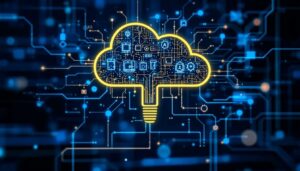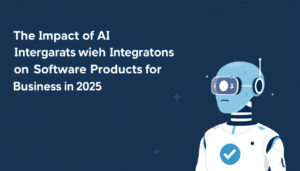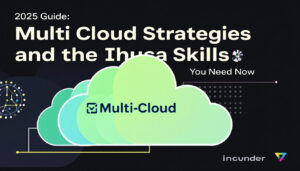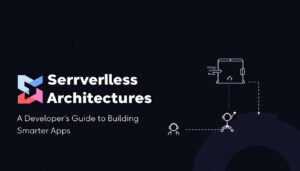Artificial intelligence and machine learning have become essential in modern cloud operations. For IT professionals, developers, electronics specialists, and business leaders, these technologies now play a key role in automating workflows, improving decision-making, and driving innovation.
This post examines how AI and ML are shaping cloud platforms through their real-world impact, current applications, and the best practices shaping industry standards. It also looks ahead to future trends that may redefine how teams manage, optimize, and scale cloud environments. Learn how AI is setting new standards for analytics, as seen in artificial intelligence setting new standards in analytics, and what this means for your organization.
How AI and Machine Learning are Transforming Cloud Operations
AI and machine learning play a fundamental role in the daily management and operation of cloud infrastructure. These technologies help automate workloads, predict system needs, and support fast, data-driven decisions. As organizations look to maintain efficiency and control costs, the integration of AI and ML into cloud management tools has become a standard.
Key Benefits of AI and ML in Cloud Management
AI and ML enhance every layer of cloud operations. Their core strengths include automation, predictive analytics, and self-optimizing systems. Teams that embrace these tools see improvements in several critical areas:
- Automated Resource Allocation: Systems use AI algorithms to evaluate usage patterns and scale resources for application demand. For example, when user traffic surges, workloads are distributed across servers with minimal manual oversight.
- Cost Optimization: Machine learning identifies resources that are underutilized and recommends or enacts changes to reduce waste. This proactive resource management keeps cloud budgets in check.
- Predictive Maintenance: Advanced analytics models flag hardware or network issues before they disrupt services, reducing unplanned downtime.
- Security Improvement: Machine learning analyzes user behaviors and system logs in real time. It detects unusual activity, triggers alerts, and blocks potential threats before damage occurs.
- Performance Optimization: Algorithms assess application performance, suggest improvements, and implement changes to keep services running smoothly.
To see how these principles apply in real-world business strategy, explore Cloud Automation Strategies, which details how automation and AI drive performance gains and savings.
For a deeper overview of these approaches, review external insights from sources such as The Role of AI and ML in Cloud Computing, which outlines a variety of concrete benefits.
Challenges in Integrating AI and ML With Cloud Infrastructure
Despite the advantages, integrating AI and ML with cloud systems comes with obstacles. Implementation often involves technical complexity and new demands on operational processes.
- Data Privacy and Compliance: Managing sensitive data under data sovereignty rules can limit how AI models train and operate, especially in regulated industries.
- Complexity of Integration: Existing infrastructures may require updates or total redesigns to support AI-driven automation and analytics tools.
- Skill Gaps: Many organizations face a shortage of staff with expertise in AI, machine learning, and cloud platforms. This can delay or complicate rollouts.
- Quality of Data: AI and ML rely on clean, extensive data sets. Inconsistent or inaccurate information can lead to faulty predictions and decisions.
- Cost of Adoption: Upfront investments in technology and training are significant, especially for businesses moving from traditional environments.
Leading providers of managed cloud services highlight these hurdles as they work to simplify integration. For more on this, the article The Role of AI and ML in Managed Cloud Services outlines practical methods for streamlining adoption while maintaining operational control.
Industry Use Cases: Real Applications of AI and Machine Learning in the Cloud
The influence of AI and machine learning in cloud environments is now evident across industries. These technologies are not just theoretical concepts; they drive critical functions in real production systems. Companies adopt AI-enabled services for automated security checks, efficient scaling of resources, and autonomous maintenance. The following subsections explore how this technology shapes security, resource management, and ongoing system health in actual cloud deployments.
Automated Security and Threat Detection
AI-powered security tools revolutionize how organizations guard cloud resources. Machine learning algorithms scan millions of logs and events in real time, identifying subtle signs of suspicious behavior that traditional methods might miss.
- Threat Detection: Models analyze user activity, detect anomalies, and correlate patterns that signal potential breaches.
- Automated Response: Upon identifying threats, AI systems can lock down compromised accounts, block malicious traffic, and notify teams—often in seconds.
- Continuous Learning: These systems improve over time, adapting to new attack methods by retraining on fresh data streams.
One sector where this approach excels is financial services, where constant monitoring and immediate response are required. As documented in Cloud security in the era of artificial intelligence, AI-driven platforms have enabled more accurate detection of insider threats and external attacks, while limiting false positives.
For a closer look at how organizations are using AI agents to automate digital processes—including security workflows—read about the role of AI agents in modern cloud operations.
Resource Optimization and Predictive Analytics
Cloud providers use AI models to analyze usage, forecast demand, and automate capacity planning. Rather than guesswork or manual allocation, this data-driven approach brings:
- Predictive Auto-scaling: Machine learning predicts when user activity will spike, then automatically increases resources before demand grows. Large e-commerce sites use this feature during major sales events to meet customer demand seamlessly.
- Resource Right-sizing: Analytics routines review workload histories, recommending optimized resource configurations for performance and cost efficiency.
- Usage Forecasting: Systems evaluate historical patterns to help teams plan budgets and growth.
Amazon EC2’s predictive scaling and Google Cloud’s scaling based on predictions are real-world examples of this application, bringing automation and intelligence to capacity planning.
Business leaders can see direct financial impact through resource savings and service improvements. For more on how predictive analytics supports smarter IT environments, the article on AI setting new analytics standards provides further insights.
Self-Healing and Proactive Maintenance
AI-driven self-healing systems monitor cloud environments for disruptions and address problems before they spread. These platforms act as always-on technicians, taking immediate actions to restore normalcy.

Key applications of self-healing and maintenance include:
- Automatic Issue Remediation: If a server crashes or an application hangs, AI scripts restart services or redirect traffic to healthy resources.
- Continuous Health Checks: Monitoring tools analyze system metrics, log files, and application responses, detecting early signs of degradation.
- Root Cause Analysis: AI models identify patterns from historical incidents, helping resolve recurring issues and further automating fixes.
Retail platforms, telecom providers, and SaaS companies rely on these capabilities for high availability and minimal downtime. To see how broader automation strategies work in the cloud, explore Cloud Automation Strategies.
These use cases illustrate how AI and ML are now essential for maintaining secure, efficient, and resilient cloud operations. The technology supports real business outcomes: stronger security, optimized costs, and uninterrupted service.
Best Practices for Leveraging AI and ML in Cloud Operations
The adoption of artificial intelligence and machine learning in cloud environments requires careful planning and adherence to proven methods. A well-structured strategy is essential to safeguard sensitive assets, deliver accurate machine learning outcomes, and maintain trust in data-driven operations. Important aspects include robust security protocols, effective model training, and rigorous data governance frameworks. These foundations support reliable and efficient cloud operations.
Ensuring Security and Compliance

Protecting AI-enabled cloud systems requires methods that address both technical threats and regulatory demands. Security best practices for AI in the cloud stress the following:
- Rigorous Identity and Access Management (IAM): Limit access to AI tools and datasets. Use multi-factor authentication and detailed user roles.
- Encryption: Use strong encryption for data at rest and in transit to reduce risk if data is intercepted or compromised.
- Activity Monitoring: Regularly review logs to detect unauthorized changes or suspicious behaviors in AI applications.
- Continuous Compliance Audits: Schedule frequent reviews to ensure adherence to data handling laws and internal standards.
Cloud teams must keep pace with regulatory changes that affect AI. Reviewing the latest guidance, such as the New Best Practices Guide for Securing AI Data, is recommended. For strategic approaches tailored to cloud products, see Cloud-Based Digital Product Security.
Building and Training Effective Machine Learning Models in the Cloud
Cloud providers enable scalable model training, supporting fast experimentation and deployment. Effective training procedures include:
- Preprocessing and Cleaning Data: Ensure inputs are accurate and formatted correctly to improve model predictions.
- Model Versioning: Track changes to models and manage deployments, supporting continuous delivery.
- Automated Training Pipelines: Use tools to automate data preparation, training, testing, and model validation.
- Hyperparameter Tuning: Test and optimize model settings to achieve high accuracy and low bias.
Modern platforms, such as Vertex AI, offer out-of-the-box services for efficient model development. They simplify automation, scaling, and retraining tasks, letting teams focus on improving outcomes rather than infrastructure management.
Maintaining Data Integrity and Governance
Establishing clear rules around data ensures accurate outcomes and builds trust across cloud stakeholders. Key points for maintaining robust data governance include:
- Establishing Data Lineage: Document where data comes from, how it is processed, and where it is stored.
- Quality Control: Run regular data validation checks throughout ingestion, transformation, and analysis.
- Ethical Use Frameworks: Set guidelines on which datasets may be used by AI models, with a focus on privacy and fairness.
- Role-based Data Controls: Assign permissions to restrict access to sensitive data.
For further insight into governing AI data effectively, review industry recommendations in How to Harness AI Data Governance for Data Integrity and explore the balance of security and usability in Understanding data governance for AI.
By maintaining discipline in each of these focus areas, organizations can maximize the value of AI and ML in their cloud operations while managing risks and meeting regulatory requirements.
Future Trends: The Evolving Role of AI and Machine Learning in Cloud Operations
As artificial intelligence and machine learning continue to advance, their roles in cloud operations are set to deepen and diversify. The next phase of development will bring a focus on adaptive automation, real-time analytics, multi-cloud orchestration, and intelligent workload distribution. Businesses and IT departments will encounter both new opportunities and increased complexity as they seek to balance flexibility, security, and efficiency in their cloud environments.
Emerging Technologies and New AI Capabilities

Several trends are shaping the future of AI-driven cloud management:
- Generative AI for Automation: Cloud platforms are beginning to integrate generative AI models to automate manual workflows, script deployment tasks, and recommend optimal configurations. These tools adapt over time, learning from user interactions to minimize effort and reduce time-to-delivery.
- Edge AI Integration: The rise of edge computing places AI-powered models closer to the data source. This enables faster decision-making for processes that demand low latency, such as factory automation or telemedicine services.
- Advanced Multi-Cloud Orchestration: AI is enhancing multi-cloud operations by analyzing usage patterns across providers, automatically shifting workloads for cost savings, reliability, or regulatory needs.
- Self-Teaching Systems: Future cloud operations will rely on AI models that learn from historical issues, user feedback, and new threats, driving continuous improvement without constant manual input.
Industry sources agree that technological advances, including quantum computing and agentic AI, are likely to redefine what’s possible in cloud management. For an in-depth look at these fast-growing trends, see Top 10 Emerging Cloud Technologies Shaping the Future and The Future of AI and Cloud Computing: Trends.
To explore emerging product trends impacting IT professionals and developers, refer to Digital product trends in IT.
Impact on IT, Development, and Business Strategies
AI and machine learning are reshaping how companies design both IT functions and broader business plans:
- IT Operations: Routine maintenance, monitoring, and scaling are more efficient with predictive automation. Teams shift focus from repetitive tasks to strategic development and innovation.
- Development Practices: DevOps workflows incorporate machine learning to spot bottlenecks, predict incidents, and automatically adjust infrastructure, accelerating release cycles and reducing human error.
- Business Strategy: Leaders use real-time analytics and intelligent forecasts to steer decision-making and allocate resources. AI-supported processes improve customer experience, adapt service delivery, and reduce costs.
The combined effect fosters a smarter and more agile organization capable of responding quickly to market and operational changes. Sources such as The Role of AI in Business Strategies Beyond and PwC’s AI Business Predictions provide expert insight into how AI adoption will inform business strategy in the coming year.
Organizations that invest today in AI-enabled cloud operations position themselves for sustained leadership and adaptability as technology—and user expectations—move forward.
Conclusion
AI and machine learning have changed the way cloud environments operate, empowering organizations to manage resources, cost, security, and performance more effectively. The ongoing adoption of these technologies brings both efficiency and adaptability for professionals across IT, development, electronics, and business. Staying current on trends and best practices ensures teams remain ready for future changes and maintain a clear advantage in a fast-moving field.
Highly skilled teams that understand these shifts are better positioned to implement strategies that drive sustained success. For those interested in related skills, understanding the top programming languages can open doors to new opportunities and help future-proof careers in AI-driven environments.
Thank you for reading. Your feedback and experiences are welcome as the industry continues to move forward.









